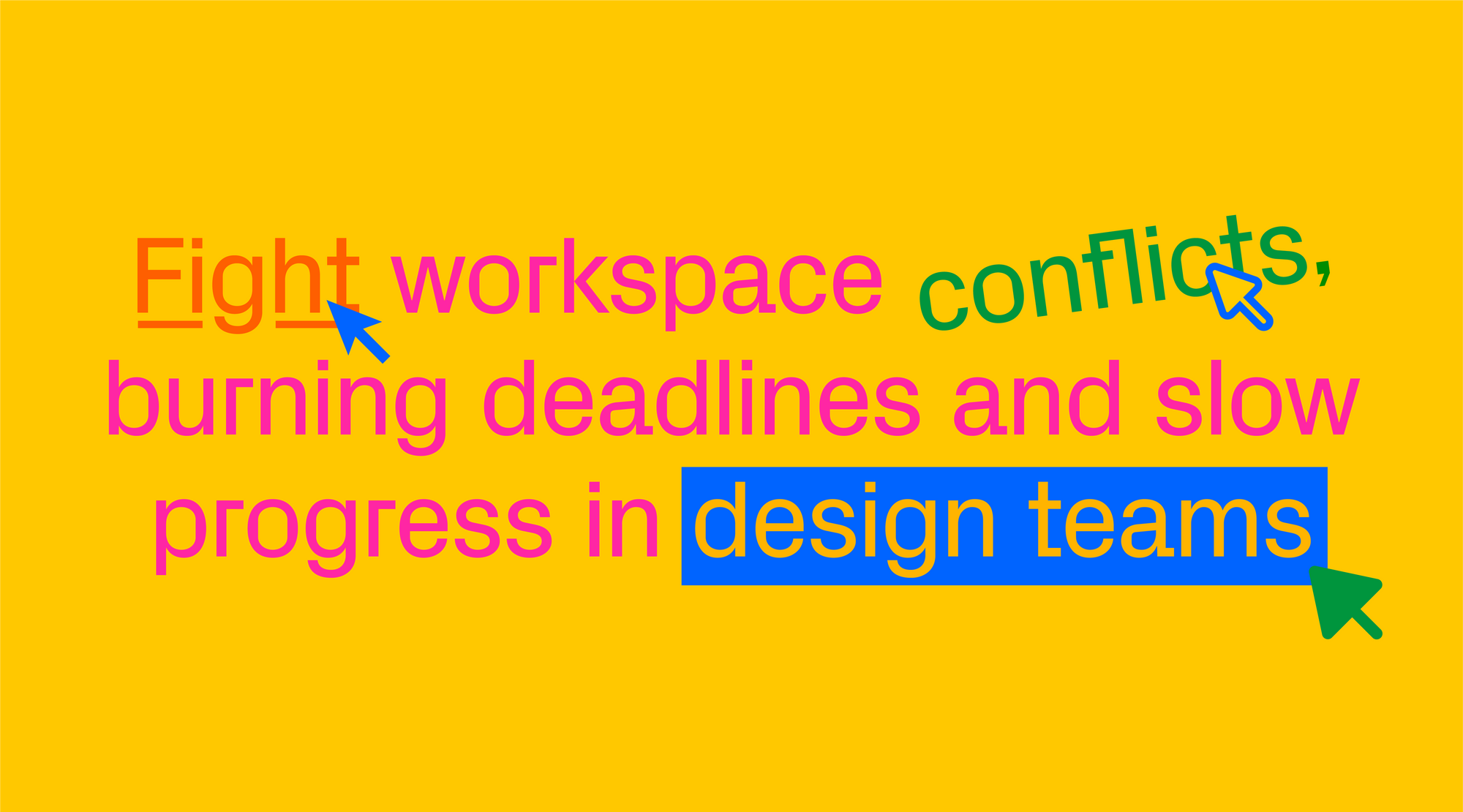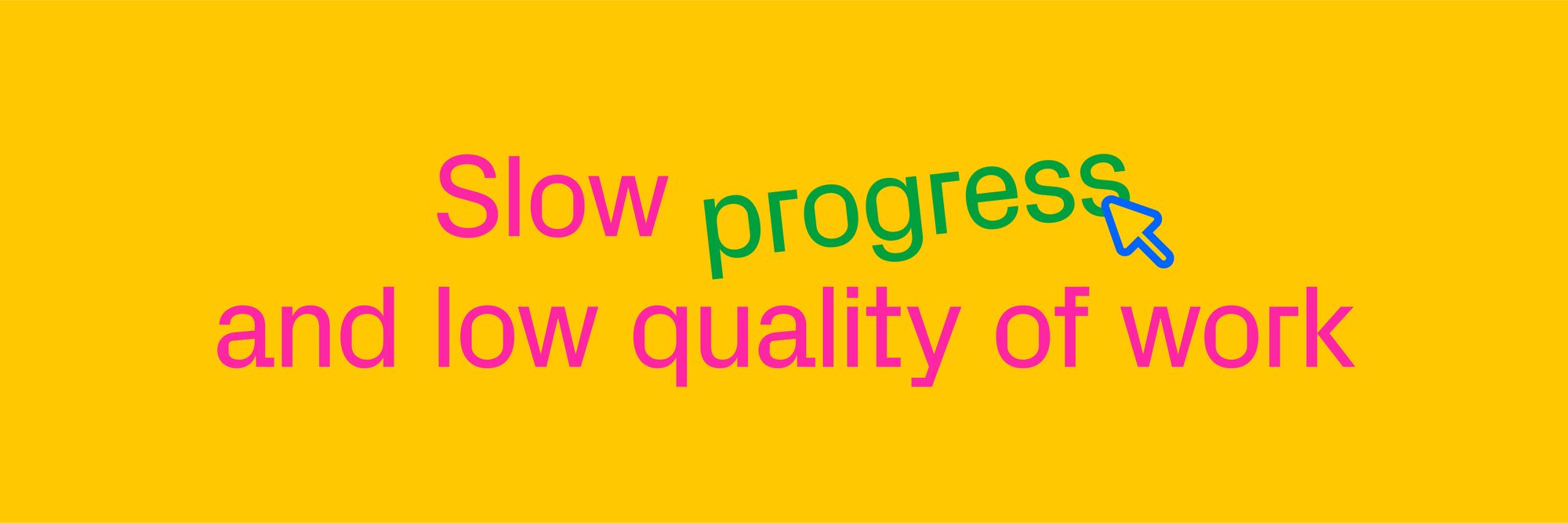Teamwork challenges and ways to cope with them
Learn how to efficiently manage the most typical issues in design teams: troubles with deadline management, conflicts and slow task progress.

There’s no doubt that a decent designer can nail a great project even for the most demanding client, although teamwork is the only way to create something that will transcend the sum of its creators. Your teammate is a second head with fresh ideas, a thoughtful critic and an ace in a specific field—and that’s a massive boost for any venture. But collaboration isn’t as simple as it may seem, as there will be creative differences, burning deadlines, poor performance and interpersonal conflicts. Some teams prefer to ignore problems, hoping they’ll just disappear, but the issues can fold together and lead to a catastrophe.
Here are typical apples of discord, along with some advice from us and Rafael Oliveira from Tracksmith on settling them wisely.

When you work independently, you're most likely in control of everything. But demanding deadlines and tricky assignments can become a disaster when many members handle one task. However, there are ways to keep it all running smoothly.
I think the main team problem is misalignment: if you have a vision and people in the team aren’t on the same page, everything can become complicated, especially if your teammates don't understand the concept after a couple of times and you have to explain it over and over again. It may also mean you’re not doing a good job of properly presenting the idea. But if there's a disconnect between what the vision is and what the execution should be, you end up with things that don't convey the original intent and then usually the goals aren’t met. — Rafael Oliveira, Creative Director at Tracksmith
Explain tasks and set measurable goals
In creative teams, members give tasks to others and collect the results. Take care of your co-workers—dig into the matter and come up with accurate task descriptions. It’s great to outline the idea first, then break down the task into points, highlighting the main parts and adding attachments needed so your team can nail the assignment.
One more helpful trick: accompany the project workload with clear and measurable goals so each member can access their personal efficiency and prepare for the next steps. There are several methods you can use to make and prioritize goals: the ICE model, which focuses on Impact, Confidence, and Ease, and the SMART system, which helps to define outcomes as Specific, Measurable, Attainable, Realistic and Timely.
Maintain a personal timeline
We’re all different: some of us are quick to approach work, while others need more time to create something. Discuss among your team who will take on urgent assignments and who will cover the rear, ask for extra days for tasks if you’re a more easygoing creator and keep your own schedule. Using a personal calendar to help you set a timeline and follow it will ease the pain. You can use one of these time management tools.
Work on crucial steps in real time
Working across time and space can play a dirty trick on you, taking away your motivation, creating a false sense of understanding of processes and delivering inconsistent results. Find time to work on planning, making decisions and handing over tasks together during video calls, sharing access to tools and synchronizing your working hours. Also, don’t be afraid to tag someone yet another time or ask the person to live chat with you if either you or they don’t get something. It might seem redundant at first, but it can work like a miracle. Human memory and the ability to follow up with the team aren’t always perfect, so it’s essential to back each other up.

Even the most creative people sometimes feel like they’ve bitten off more than they can chew and grow tired of working at a fast pace or finding out they’ve been assigned to a task that’s outside their competency level. The good news is that such situations can be prevented.
Distribute the team roles
We can’t know everything or perform equally well in every aspect of the job. Some people are better at illustration, others know the best kinds of type, and still others have a handle on coloring. Determine what you’re best at and communicate your strong points to your team, delegating tasks to the right people and optimizing resources for extra productivity.
When working on a project, we define the idea and the end goal and then figure out who in the team has the better skill set to approach one task or the other. In case of a catalog design, for instance, nailing the job can mean not just creating a catalog but also making one thing feel at home with the other in the campaign. Sometimes our distribution comes down to determining who has fewer things on their plate and can successfully tackle the project, which also works well. — Rafael Oliveira, Creative Director at Tracksmith
Use the right tools
Promoting proper creative and management tools to enhance seamless design collaboration is crucial. An effective tool takes down most of the barriers and saves time on feedback and approvals by synchronizing your team’s actions and allowing you to easily refine your shared creations.
Share great design examples
We all need inspiration, but designers need shared inspiration to march in lockstep. To keep the creative process more diverse and innovative, you can share awesome design projects, tricks and trends that resonate with your current goals. This could be done using a separate chat for inspiration, a shared folder, a mood board, or weekly meetings to showcase newly discovered gems.
Our mission as a brand is to make people fall in love with running. Of course, there will always be a commercial part because we are selling running products. But we intend to make people see running as we do, as a beautiful and simple sport you can add to your life. We've been lucky to find teammates who share our love for running, as they're runners themselves. So they understand the subject matter very closely and speak to it more directly, which is always a benefit. — Rafael Oliveira, Creative Director at Tracksmith
Exchange knowledge and be willing to help
In teams, all successes and failures are shared. Help one another with problems big and small, offer advice and spare hands if someone’s stuck. But always keep an eye on your workload so you won’t get burned out and frustrated.
Your team can also benefit from a shared knowledge base. Don’t put aside professional books you’ve read or seminars you’ve watched, but add them to a team space where everyone can pick up new information.
Hold retrospectives to look back on projects
A properly held retrospective can really help to improve future collaborations. It’s not just about having a formal call to mark the project’s end, but about having a detailed look back on things to understand how previous experience can influence future processes. If you’re a newcomer to retrospectives, try this handbook. Once you’ve learned the lessons properly, problems that have hampered you on some projects won’t move on to other ventures.
In the current day and age, we're always busy working towards the next thing, so it's hard for a group of individuals to look back, reflect and adjust. But I am doing retros personally as a part of my role. I stop for a bit to see whether we did our best, to check what we accomplished or didn't accomplish, and to think about how I can adjust the next steps. — Rafael Oliveira, Creative Director at Tracksmith

Conflicts and misunderstandings over other points of view are unavoidable in any group of professionals working together. Design teams are no exception. But the good news is that any confrontation can be managed successfully with tolerance, adaptability and a willingness to speak up and actively listen.
Communicate person to person
Your work is not only about work. Hold personal meetings with each other, and be a person for a person, not a function for a function. Always communicate ups, downs and possible options with one another, even if it seems like too much talking. Every working process will run more smoothly if team members have friendly off-the-job chats, share some activities or discuss honest personal concerns one-on-one or in small groups.
Encourage each other
‘Thank you, you did a marvelous job’ isn’t just for significant assignments. People tend to be more enthusiastic about new tasks if their previous contributions are duly appreciated. So, find kind words for your teammates as part of your everyday routine so everyone feels that they have a place filled with understanding and that their ideas are important and seen. By the way, consider adding Kudo cards to your team routine as an effective and elegant way to express gratitude and give feedback.
Successful collaboration is about a conversation that needs to happen along the way. It is vital to give and take feedback from a team. There is one trick that helps me is to disagree, but commit. If I see an idea that comes from any part, even if I don’t relate to it, I try to understand the point of view, commit and lend my skill set to make it the best possible thing it can be according to our collective vision. — Rafael Oliveira, Creative Director at Tracksmith
Practice polite peer review
Creative teams typically have internal reviews. One example is the well-known 360 review method that allows team members to discuss every nuance of a project so there will be no misconceptions or rough edges. While this process will almost certainly include some kind of criticism, constructive reviews help team members to become more confident in the project steps, grow as professionals and contribute to the common good. Don’t be afraid of giving negative feedback, but do think about what you have to say to your peers before you speak, use “I” Messages and criticize the idea, not the person.
If you're honest and your feedback comes from a place of respect for the other person and their work, you’ll eventually settle things. Softening issues out or being overly kind might just not work right. Constructive criticism is more respectful towards your teammate than just saying that the work was not very good. I respect people and the work they bring to the table, and being honest, which is a higher level of respect, is conveying precisely what should be conveyed so that people can adjust their work towards the goals. But keep in mind that when giving harsh criticism, you need to think hard about the words you're going to use. — Rafael Oliveira, Creative Director at Tracksmith